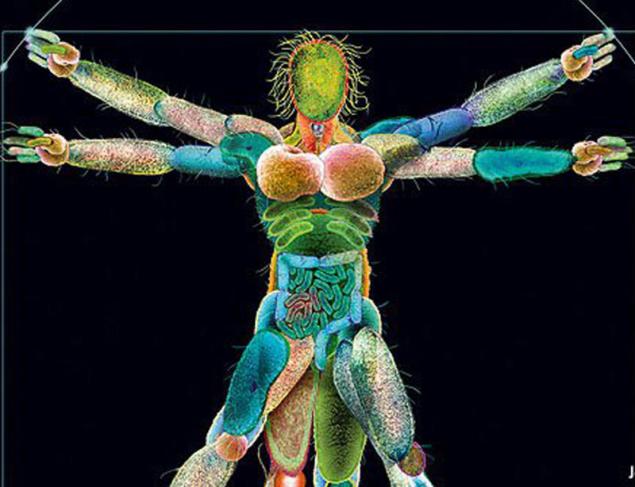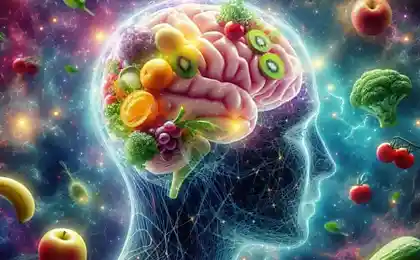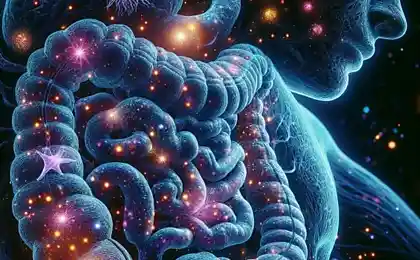618
About the microbiome: How microbes control the health of the people
Scientists are only now beginning to understand how great the role of microorganisms living inside the human
Richard Conniff (Conniff) ... the Pediatrician Barbara Warner will never forget this couple. Before admission to the clinic, for many years, the couple tried in vain to have children, and so, in 1997, a patient of Dr. Warner finally got pregnant. She was then about forty-five years. "For her it was the last chance," explains Warner. And behold, soon came to light two twins. Unfortunately, the first died as a result of severe asphyxia, in those days, the most common killer of premature infants.
After a week, straight to Thanksgiving, Warner swaddled second, the surviving twin and... even now, the doctor remembers with horror that she saw redness (erythema) and bloating.
Diagnosis: necrotizing enterocolitis (abbreviated as NEK). About the disease outside of the neonatal intensive care units children in General, few have heard; necrotizing enterocolitis are caused by bacteria and is characterized by sudden and rapidly developing inflammation of the intestines.
During surgery on the abdomen of the baby, the surgeon saw the following picture: the whole intestinal tract, from the stomach to the rectum — is not functioning at all. The kid was doomed. After surgery, Dr. Warner, in tears, returned the newborn, the grieving parents, not being able to help them.
"Since then 15 years have passed and nothing has changed," gloomily concludes Warner, in passing a plastic incubators, which are its tiny patients, coiled tubing, and the receiving bath soft ultraviolet. Necrotizing enterocolitis remains one of the biggest killers of premature babies. However, soon the situation may change, thanks to new knowledge about nature and human life.
Over the past few years, advances in genetic engineering have opened a window into the amazing, crowded, not visible to the human eye, but of great significance for the human world of microorganisms that live inside and around us — the world of bacteria, fungi and viruses.
Scientists call it the "microbiome". The study of microbiome has engaged in "big science" by connecting to the international research community of scientists, used advanced DNA sequencing technology and huge databases, the processing of which on the shoulder only to supercomputers. Studies of the microbiome signify the great strides that medicine has not been doing for the past hundred and fifty years; now scientists understand that germs can be not only enemies but also his allies.

The question raised in the article are quite delicate. In the intensive care unit of the hospital Saint Louis where Dr. Warner, the scientists studying necrotizing enterocolitis (NEC), analyzed literally every diaper and every diaper, which was wrapped preterm infants fall into this medical institution for the past three years.
Scientists do not set themselves the task, as it was before in the history of medicine, certainly to identify a particular pathogen, some "killer" virus or bacterium. Instead, says Phillip Tarr, a pediatric gastroenterologist from the University of Washington and a colleague of Dr. Warner, scientists want to learn how to control the balance of microflora, and for that to study features of the functioning of the hundreds of types of microorganisms that inhabit the intestines of infants.
Scientists want to find out under what conditions developing necrotizing enterocolitis, and perhaps they will be able for the first time in the history of medicine to offer the doctors working in neonatal intensive care units, recommendations for the prevention of this deadly disease.
In the beginning of this year one group of researchers found that the secretions produced by some gut bacteria, apparently, able to prevent necrotizing enterocolitis in the stage which leads to death. Thus, it is likely that doctors will soon be able to understand the causes of the neck, about which little is known today, and to finally adopt preventive measures.
Today, doctors and biologists began to pay increased attention to the study of the microbiome, as it makes a fresh look at the problem for the NEC and to better understand the essence of human nature. For example, we tend to think that man is only the collection of cells, of which built the human body; the number of these cells exceeds ten trillion. But to this figure we must add another 100 trillion cells that make up organisms, which people sheltered in his body. It turns out that living creature that each of us sees in the morning mirror, only 10 percent of the cells belonging to the actual person.
Even more impressive are data on the weight living in a man microorganisms: in total, the adult human it is about three pounds (almost same weighs the human brain). Now to the genes in the human body there are approximately 21 thousand. To this figure we must add the nearly eight million genes that comprise the human body inhabiting microorganisms, many of which help us digest food, strengthen the immune system, "include" and "turn off" our genes — in short, help us to live.
It is impossible not to recall the famous statement of the English poet John Donne: "No man is an island, full of himself, every man is a piece of the continent, a part of the one whole." And I remember a line in one of the old songs of the American rock group "Jefferson Airplane", "He is a Peninsula". In fact, in our case, we have to go on a hefty metropolis.
The beginning of an era of the microbiome can be counted from the end of 1990-ies, when David Relman (Relman), the infectious disease specialist, working at Stanford University, decided to get a sample of the microflora inhabiting the oral cavity. The procedure is simple: the dentist makes a cotton swab in the cheek, takes a smear from the surface of the teeth or gums. On a cotton swab seems to be nothing (but, according to one dentist, "faith in the invisible must be extremely strong").
After this, the samples sent to the laboratory for culturing in a Petri dish and detect those microorganisms that there feel good. Elman proposed a bold idea — to analyze DNA using the method of sequencing. Since then, the cost of sequencing has decreased, and the study of samples swabs taken from different areas of the human body for DNA testing, has become commonplace in the study of the microbiome.

In the laboratory each of the samples of the swabs placed in one of the 96 cells arranged on a small plastic plate. After a series of manipulations, the samples received at a device called sequencer, which looks something like an ATM machine and a Minibar at a time.
The information gives us the sequencer, is impressive: it turned out that the microflora of the human oral cavity comprises more than 1000 species of microorganisms; wherein, in a region located behind the ear, 150 living species; on the inner side of the forearm — 440 species, and in the intestines of several thousand.
In fact, the microflora is present in almost all areas of the human body. Just as in the human body there are more than 10 thousand species. Their number varies depending on which part of the body we see; in this sense, in the opinion of the specialist in the study of microflora Rob knight from the University of Colorado, the differences in the number of microorganisms inhabiting the oral cavity and intestines, even greater than the difference between the temperature of the hot water and polar ice.
For example, according to the 2010 study, the number of microorganisms living on the right and left hand, is only 17 percent of the total number of all microorganisms inhabiting the human body.
But the interesting thing is that the community of microorganisms residing in the human body greatly affects the way of life and even his way of thinking and perception. Recent studies have established a link between changes in the microbiome and some of the most common diseases, including obesity, allergies, diabetes, bowel dysfunction and even mental illness such as autism, schizophrenia and depression.
Last year, for example, scientists managed to establish the following facts:
In particular, great interest was published in June last year, the first results of the project "Human Microbiome Project" worth 173 million dollars, conducted under the auspices of the National Institute of health. The aim of this project is to create detailed maps of the microflora inhabiting the body of three hundred healthy volunteers.
Doctors equate this project to the discovery in the human body of another, hitherto unknown, of an organ or another, not previously known, the system of life. As stated in one of the articles published in the January issue of the American journal of epidemiology this year, scientists discovered the "one key" that will help "open the proverbial black box" which determines health and disease.

About the microbiome now I know even non-experts, especially since a few years ago, researchers from Washington University have established a link between obesity and quality of microflora. It turned out that in the gut in mice suffering from excess weight, was dominated by Firmicutes bacteria, while thin — Bacteroidetes.
In the experiment, both groups of mice were kept on the same diet, however, it appeared that the mice, whose gut was dominated by bacteria of the Firmicutes type and extract more calories and accumulate more fat. The same thing happened in the human body. Now I understand why many overweight people often complain that they get fat even, so to speak, from the mere smell of food without any problems absorb their skinny friends.
Such experiments have generated great enthusiasm for the human microbiome, which previously most scientists looked with a certain amount of disgust. It's as if the readers would love suddenly "Gulliver's Travels" only one passage in which Jonathan swift depicts a student who was engaged in turning human excrement back into the nutrients from which they are formed.
This winter, two competing projects were invited enthusiasts to take their analysis feces, and swabs from the oral cavity and the skin surface. To the Bank account of each of the projects received more than 300 thousand dollars in donations (average donations — $ 100) In the first of the projects that was implemented by the knight Lab at the University of Colorado called "American Gut", involved leading American scientists.
In this project, customers were offered services on the preparation of a "map of the ecosystem of intestinal bacteria the human" cost $ 99, which the magazine "Prevention" was named one of the ten best holiday gifts. (And romantics for individual couples were offered the package called "Microbes for two" for $ 189, which also gave the right to analyze samples of the feces of both partners. Or their dogs.)
In the second project called uBiome has developed the idea of the so to say "popular science". The participants were asked to formulate hypotheses for experimental testing, for example: "How alcohol consumption affects the human microbiome?" "What is the impact on the microbiome has a vegetarian diet?"
After in December, one of the organizers of the project Villa Ludington child was born, the father began to conduct daily analysis of the feces of their newborn son, Dylan, to answer the question: "How inherited microflora colonizing the gut of the infant during the first year of life?"
The issue of microbiome enthusiastically addressed and venture capitalists. To date, they have already invested in at least four new projects to develop promising drugs and diagnostic tools, focused on the microbiome.
Executive Director of "Second Genome", located on the outskirts of San Francisco, Peter Dilaura (DiLaura) has already invested about $ 10 million to the project, which after three years it would be possible to begin clinical trials of medicines intended for the treatment of such widespread diseases as ulcerative colitis, the cause of which is likely to be a change in microbiome. (By the way, the slogan of the company "Second Genome": "the Most important for the human body genome may not be of human origin").
As you can see, the plans look optimistic, especially considering that begun in the time of the study of the human genome, contrary to expectations, practically led to the emergence of new methods of treatment. But, at least, they theoretically should help to find ways of manipulation of individual groups of microorganisms.
In some large pharmaceutical companies who are working on a solution to the problem of diabetes and obesity, was created by the research division, engaged in the study of the microbiome. In addition, major manufacturers of toothpaste and liquid mouthwash, already investing in the development of microbiological methods in the fight against tooth decay.

But in addition to creating commercial products, the mere possibility of mapping the human microbiome are already able to bring enormous benefits to medicine. Studies show that each person has a unique microbiota that is unique to him. The differences between the characteristics of the microflora of the individual depend on the characteristics of his individual diet, family structure, medical history, national and regional differences, and many other factors — all of them in varying degrees, play a role.

For example, the human intestine can inhabit some bacteria, which are generally able to change the nature of the therapeutic effects of certain drugs, to the extent that microorganisms can be neutralized by drugs such as acetaminophen (a component that is part of the pain medication Tylenol).
Currently, doctors sometimes have to pick up the medicine that could really help the patient. However, if we examine the individual microbeam of the patient, in this case, the selection of the drug will undoubtedly accelerate. However, some experts believe that the enthusiasm towards the microbiome is the next fad, which only promises mountains of gold.published
Live food — the joy of natural flavors without the toxins
How does the brain: the substantia nigra
P. S. And remember, only by changing their consumption — together we change the world! ©
Source: inosmi.ru/world/20130528/209413689.html
Richard Conniff (Conniff) ... the Pediatrician Barbara Warner will never forget this couple. Before admission to the clinic, for many years, the couple tried in vain to have children, and so, in 1997, a patient of Dr. Warner finally got pregnant. She was then about forty-five years. "For her it was the last chance," explains Warner. And behold, soon came to light two twins. Unfortunately, the first died as a result of severe asphyxia, in those days, the most common killer of premature infants.
After a week, straight to Thanksgiving, Warner swaddled second, the surviving twin and... even now, the doctor remembers with horror that she saw redness (erythema) and bloating.
Diagnosis: necrotizing enterocolitis (abbreviated as NEK). About the disease outside of the neonatal intensive care units children in General, few have heard; necrotizing enterocolitis are caused by bacteria and is characterized by sudden and rapidly developing inflammation of the intestines.
During surgery on the abdomen of the baby, the surgeon saw the following picture: the whole intestinal tract, from the stomach to the rectum — is not functioning at all. The kid was doomed. After surgery, Dr. Warner, in tears, returned the newborn, the grieving parents, not being able to help them.
"Since then 15 years have passed and nothing has changed," gloomily concludes Warner, in passing a plastic incubators, which are its tiny patients, coiled tubing, and the receiving bath soft ultraviolet. Necrotizing enterocolitis remains one of the biggest killers of premature babies. However, soon the situation may change, thanks to new knowledge about nature and human life.
Over the past few years, advances in genetic engineering have opened a window into the amazing, crowded, not visible to the human eye, but of great significance for the human world of microorganisms that live inside and around us — the world of bacteria, fungi and viruses.
Scientists call it the "microbiome". The study of microbiome has engaged in "big science" by connecting to the international research community of scientists, used advanced DNA sequencing technology and huge databases, the processing of which on the shoulder only to supercomputers. Studies of the microbiome signify the great strides that medicine has not been doing for the past hundred and fifty years; now scientists understand that germs can be not only enemies but also his allies.

The question raised in the article are quite delicate. In the intensive care unit of the hospital Saint Louis where Dr. Warner, the scientists studying necrotizing enterocolitis (NEC), analyzed literally every diaper and every diaper, which was wrapped preterm infants fall into this medical institution for the past three years.
Scientists do not set themselves the task, as it was before in the history of medicine, certainly to identify a particular pathogen, some "killer" virus or bacterium. Instead, says Phillip Tarr, a pediatric gastroenterologist from the University of Washington and a colleague of Dr. Warner, scientists want to learn how to control the balance of microflora, and for that to study features of the functioning of the hundreds of types of microorganisms that inhabit the intestines of infants.
Scientists want to find out under what conditions developing necrotizing enterocolitis, and perhaps they will be able for the first time in the history of medicine to offer the doctors working in neonatal intensive care units, recommendations for the prevention of this deadly disease.
In the beginning of this year one group of researchers found that the secretions produced by some gut bacteria, apparently, able to prevent necrotizing enterocolitis in the stage which leads to death. Thus, it is likely that doctors will soon be able to understand the causes of the neck, about which little is known today, and to finally adopt preventive measures.
Today, doctors and biologists began to pay increased attention to the study of the microbiome, as it makes a fresh look at the problem for the NEC and to better understand the essence of human nature. For example, we tend to think that man is only the collection of cells, of which built the human body; the number of these cells exceeds ten trillion. But to this figure we must add another 100 trillion cells that make up organisms, which people sheltered in his body. It turns out that living creature that each of us sees in the morning mirror, only 10 percent of the cells belonging to the actual person.
Even more impressive are data on the weight living in a man microorganisms: in total, the adult human it is about three pounds (almost same weighs the human brain). Now to the genes in the human body there are approximately 21 thousand. To this figure we must add the nearly eight million genes that comprise the human body inhabiting microorganisms, many of which help us digest food, strengthen the immune system, "include" and "turn off" our genes — in short, help us to live.
It is impossible not to recall the famous statement of the English poet John Donne: "No man is an island, full of himself, every man is a piece of the continent, a part of the one whole." And I remember a line in one of the old songs of the American rock group "Jefferson Airplane", "He is a Peninsula". In fact, in our case, we have to go on a hefty metropolis.
The beginning of an era of the microbiome can be counted from the end of 1990-ies, when David Relman (Relman), the infectious disease specialist, working at Stanford University, decided to get a sample of the microflora inhabiting the oral cavity. The procedure is simple: the dentist makes a cotton swab in the cheek, takes a smear from the surface of the teeth or gums. On a cotton swab seems to be nothing (but, according to one dentist, "faith in the invisible must be extremely strong").
After this, the samples sent to the laboratory for culturing in a Petri dish and detect those microorganisms that there feel good. Elman proposed a bold idea — to analyze DNA using the method of sequencing. Since then, the cost of sequencing has decreased, and the study of samples swabs taken from different areas of the human body for DNA testing, has become commonplace in the study of the microbiome.

In the laboratory each of the samples of the swabs placed in one of the 96 cells arranged on a small plastic plate. After a series of manipulations, the samples received at a device called sequencer, which looks something like an ATM machine and a Minibar at a time.
The information gives us the sequencer, is impressive: it turned out that the microflora of the human oral cavity comprises more than 1000 species of microorganisms; wherein, in a region located behind the ear, 150 living species; on the inner side of the forearm — 440 species, and in the intestines of several thousand.
In fact, the microflora is present in almost all areas of the human body. Just as in the human body there are more than 10 thousand species. Their number varies depending on which part of the body we see; in this sense, in the opinion of the specialist in the study of microflora Rob knight from the University of Colorado, the differences in the number of microorganisms inhabiting the oral cavity and intestines, even greater than the difference between the temperature of the hot water and polar ice.
For example, according to the 2010 study, the number of microorganisms living on the right and left hand, is only 17 percent of the total number of all microorganisms inhabiting the human body.
But the interesting thing is that the community of microorganisms residing in the human body greatly affects the way of life and even his way of thinking and perception. Recent studies have established a link between changes in the microbiome and some of the most common diseases, including obesity, allergies, diabetes, bowel dysfunction and even mental illness such as autism, schizophrenia and depression.
Last year, for example, scientists managed to establish the following facts:
- the tendency to gain weight in those infants who were exposed to antibiotics in the first six months of life, 22 percent higher than those toddlers that such an impact did not feel myself; perhaps, the reason here is that antibiotics are detrimental to the microorganisms necessary for human life.
- the lack of beneficial microflora in the gut of rodents at an early age leads to a disorder of the Central nervous system and is able to continuously change the level of serotonin in the brain of an adult individual. Scientists suggest that in humans the same thing happens.
- according to a study carried out in Malawi to address hunger among children need not only food, but also the presence in the intestine of the child the "right" microorganisms.
In particular, great interest was published in June last year, the first results of the project "Human Microbiome Project" worth 173 million dollars, conducted under the auspices of the National Institute of health. The aim of this project is to create detailed maps of the microflora inhabiting the body of three hundred healthy volunteers.
Doctors equate this project to the discovery in the human body of another, hitherto unknown, of an organ or another, not previously known, the system of life. As stated in one of the articles published in the January issue of the American journal of epidemiology this year, scientists discovered the "one key" that will help "open the proverbial black box" which determines health and disease.

About the microbiome now I know even non-experts, especially since a few years ago, researchers from Washington University have established a link between obesity and quality of microflora. It turned out that in the gut in mice suffering from excess weight, was dominated by Firmicutes bacteria, while thin — Bacteroidetes.
In the experiment, both groups of mice were kept on the same diet, however, it appeared that the mice, whose gut was dominated by bacteria of the Firmicutes type and extract more calories and accumulate more fat. The same thing happened in the human body. Now I understand why many overweight people often complain that they get fat even, so to speak, from the mere smell of food without any problems absorb their skinny friends.
Such experiments have generated great enthusiasm for the human microbiome, which previously most scientists looked with a certain amount of disgust. It's as if the readers would love suddenly "Gulliver's Travels" only one passage in which Jonathan swift depicts a student who was engaged in turning human excrement back into the nutrients from which they are formed.
This winter, two competing projects were invited enthusiasts to take their analysis feces, and swabs from the oral cavity and the skin surface. To the Bank account of each of the projects received more than 300 thousand dollars in donations (average donations — $ 100) In the first of the projects that was implemented by the knight Lab at the University of Colorado called "American Gut", involved leading American scientists.
In this project, customers were offered services on the preparation of a "map of the ecosystem of intestinal bacteria the human" cost $ 99, which the magazine "Prevention" was named one of the ten best holiday gifts. (And romantics for individual couples were offered the package called "Microbes for two" for $ 189, which also gave the right to analyze samples of the feces of both partners. Or their dogs.)
In the second project called uBiome has developed the idea of the so to say "popular science". The participants were asked to formulate hypotheses for experimental testing, for example: "How alcohol consumption affects the human microbiome?" "What is the impact on the microbiome has a vegetarian diet?"
After in December, one of the organizers of the project Villa Ludington child was born, the father began to conduct daily analysis of the feces of their newborn son, Dylan, to answer the question: "How inherited microflora colonizing the gut of the infant during the first year of life?"
The issue of microbiome enthusiastically addressed and venture capitalists. To date, they have already invested in at least four new projects to develop promising drugs and diagnostic tools, focused on the microbiome.
Executive Director of "Second Genome", located on the outskirts of San Francisco, Peter Dilaura (DiLaura) has already invested about $ 10 million to the project, which after three years it would be possible to begin clinical trials of medicines intended for the treatment of such widespread diseases as ulcerative colitis, the cause of which is likely to be a change in microbiome. (By the way, the slogan of the company "Second Genome": "the Most important for the human body genome may not be of human origin").
As you can see, the plans look optimistic, especially considering that begun in the time of the study of the human genome, contrary to expectations, practically led to the emergence of new methods of treatment. But, at least, they theoretically should help to find ways of manipulation of individual groups of microorganisms.
In some large pharmaceutical companies who are working on a solution to the problem of diabetes and obesity, was created by the research division, engaged in the study of the microbiome. In addition, major manufacturers of toothpaste and liquid mouthwash, already investing in the development of microbiological methods in the fight against tooth decay.

But in addition to creating commercial products, the mere possibility of mapping the human microbiome are already able to bring enormous benefits to medicine. Studies show that each person has a unique microbiota that is unique to him. The differences between the characteristics of the microflora of the individual depend on the characteristics of his individual diet, family structure, medical history, national and regional differences, and many other factors — all of them in varying degrees, play a role.

For example, the human intestine can inhabit some bacteria, which are generally able to change the nature of the therapeutic effects of certain drugs, to the extent that microorganisms can be neutralized by drugs such as acetaminophen (a component that is part of the pain medication Tylenol).
Currently, doctors sometimes have to pick up the medicine that could really help the patient. However, if we examine the individual microbeam of the patient, in this case, the selection of the drug will undoubtedly accelerate. However, some experts believe that the enthusiasm towards the microbiome is the next fad, which only promises mountains of gold.published
Live food — the joy of natural flavors without the toxins
How does the brain: the substantia nigra
P. S. And remember, only by changing their consumption — together we change the world! ©
Source: inosmi.ru/world/20130528/209413689.html
This may be the cause of bad breath: delete it and solve the problem
7 tools that will soothe the symptoms of arthritis























